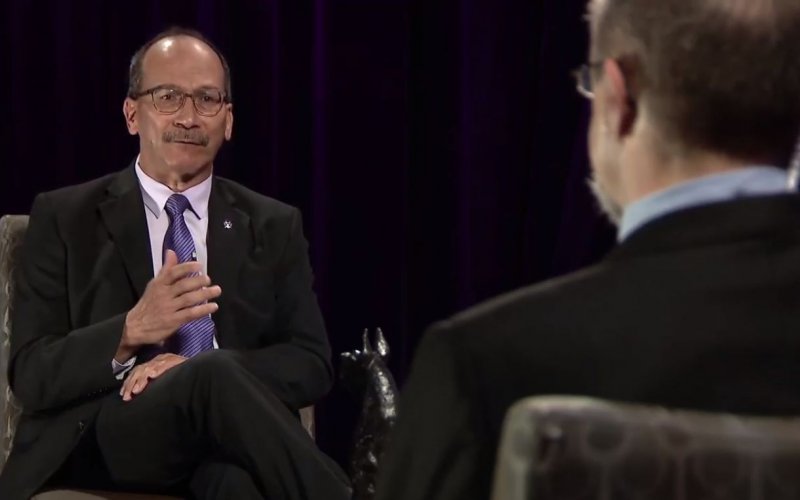President outlines brighter financial future in his Spring Address

ALBANY, N.Y. (May 6, 2021) — After the many challenges caused by the COVID-19 pandemic, this year’s Spring University Address offered new hope on the horizon. The address, delivered live from the Professional Development Program studio via an online webinar on April 29, included remarks from University Senate Chair Sean Rafferty and President Havidán Rodríguez, and was followed by a comprehensive question-and-answer session.
“As we emerge from this very challenging year, we still have our work cut out for us,” the president said, “but we also have excellent opportunities to seize on, and many reasons to celebrate.”
One reason is an improved financial situation. Between federal stimulus funding and a new state budget that is more favorable to the University than was anticipated, the University was able to decrease its budget reduction target from $38 million to $33 million. And of that total, the University has already reached $25 million in structural savings – with no layoffs, retrenchments, program closures or cuts to scholarship funds, the president said.
While the president acknowledged that all cuts are painful, the remaining $8 million in needed reductions can be spaced out over the next four years, “a welcome reprieve,” he said.
The state budget also increases funding for EOP and TAP, and will eliminate by 2024-2025 the so-called “TAP gap”— the difference between Tuition Assistance Program grants to students and their actual tuition, which will ultimately save the University $6.5 million a year. In addition, the state more than tripled funding to the Center of Excellence for Weather & Climate Analytics, to $800,000 a year.
The president also announced the creation of a new, $1 million endowed scholarship fund for the University’s EOP program, and added that the endowment is expected to double through matching gifts. “This will provide meaningful support to address the significant financial barriers EOP students face,” he said.
“The University at Albany Foundation has endowed this scholarship funding for EOP students, and will be raising another $1 million to further increase support for this tremendous program,” Vice President for University Advancement Fardin Sanai later explained.
The Office of Diversity and Inclusion has also been strengthened with a new $500,000 endowment and another $150,000 for ODI initiatives, the president announced in his address. These funds came in part from the University’s $162 million capital campaign.
Rodríguez also said that given the changing demographics in the state and the country, it is important to target adult learners through a heightened focus on recruitment and programming, including professional and certificate programs, and increased online offerings.
The president mentioned other points highlighting the University’s successes and engagement over the past year, including:
- Hosting the state’s vaccination site, and running several internal vaccination PODs for faculty, staff and students, as well as the RNA Institute processing more than 126,000 COVID-19 tests
- Procuring $800,000 in SUNY PRODiG funds to support faculty diversity efforts
- Planning a Fall 2021 semester that is much closer to the pre-pandemic normal, with in-person classes and events as well as continuing safety measures
- Convening the Minority Health Disparities Research Collaborative to study the disproportionate impact of COVID-19 on communities of color
Going forward, Rodríguez said, it is important to focus on the University’s strengths, and to that end he invited the University community to review a draft Signature Strengths document, accessible through MyUAlbany. The document proposes to increase UAlbany’s impact by leveraging the university's unique cluster of future-facing academic and research programs, including emergency preparedness, cybersecurity, climate science, health sciences and public policy.
The president emphasized that this “emerging framework” would emphasize interdisciplinarity, drawing on the arts, humanities, social sciences and STEM fields, and noting that the Minority Health Disparities Collaborative provides a strong model for this approach.
Watch the full video recording of the Spring University Address.




